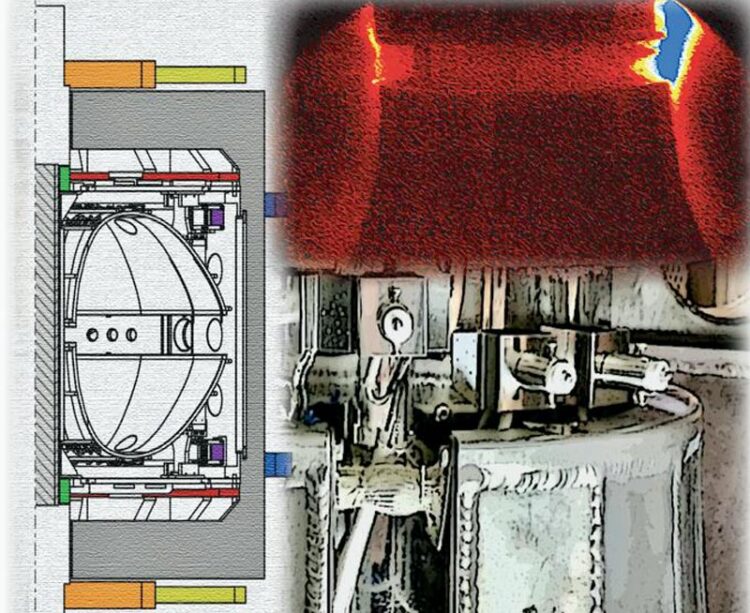Fusion model hot off the wall

Rotational temperatures of hydrogen molecules desorbed from plasma-facing surface was measured in three different tokamaks; the increases of the temperature due to collisional-radiative processes in the plasmas were also evaluated.
Credit: KyotoU Global Comms/Taiichi Shikama
Predicting molecular rotational temperature for enhanced plasma recombination.
Humans may never be able to tame the Sun, but hydrogen plasma — making up most of the Sun’s interior — can be confined in a magnetic field as part of fusion power generation: with a caveat.
The extremely high temperature plasmas, typically as high as 100 million degrees Celsius, confined in the tokamaks — donut-shaped fusion reactors — cause damage to the containment walls of these mega devices. Researchers inject hydrogen and inert gases near the device wall to cool the plasma by radiation and recombination, which is the reverse of ionization. Heat load mitigation is critical to extending the lifetime of future fusion device.
Understanding and predicting the process of the vibrational and rotational temperatures of hydrogen molecules near the walls could enhance the recombination, but effective strategies have remained elusive.
An international team of researchers led by Kyoto University has recently found a way to explain the rotational temperatures measured in three different experimental fusion devices in Japan and the United States. Their model evaluates the surface interactions and electron-proton collisions of hydrogen molecules.
“In our model, we targeted the evaluation on the rotational temperatures in the low energy levels, enabling us to explain the measurements from several experimental devices,” adds corresponding author Nao Yoneda of KyotoU’s Graduate School of Engineering.
By enabling the prediction and control of the rotational temperature near the wall surface, the team was able to dissipate plasma heat flux and optimize the devices’ operative conditions.
“We still need to understand the mechanisms of rotational-vibrational hydrogen excitations,” Yoneda reflects, “but we were pleased that the versatility of our model also allowed us to reproduce the measured rotational temperatures reported in literature.”
The paper “Spectroscopic measurement of increases in hydrogen molecular rotational temperature with plasma-facing surface temperature and due to collisional-radiative processes in tokamaks” appeared on 27 July 2023 in Nuclear Fusion, with doi: 10.1088/1741-4326/acd4d1
About Kyoto University
Kyoto University is one of Japan and Asia’s premier research institutions, founded in 1897 and responsible for producing numerous Nobel laureates and winners of other prestigious international prizes. A broad curriculum across the arts and sciences at undergraduate and graduate levels complements several research centers, facilities, and offices around Japan and the world.
For more information, please see: http://www.kyoto-u.ac.jp/en
Journal: Nuclear Fusion
DOI: 10.1088/1741-4326/acd4d1
Method of Research: Computational simulation/modeling
Subject of Research: Not applicable
Article Title: Spectroscopic measurement of increases in hydrogen molecular rotational temperature with plasma-facing surface temperature and due to collisional-radiative processes in tokamaks
Article Publication Date: 27-Jul-2023
Media Contact
Jake G. Tobiyama
Kyoto University
tobiyama.gakuji.6y@kyoto-u.ac.jp
All latest news from the category: Power and Electrical Engineering
This topic covers issues related to energy generation, conversion, transportation and consumption and how the industry is addressing the challenge of energy efficiency in general.
innovations-report provides in-depth and informative reports and articles on subjects ranging from wind energy, fuel cell technology, solar energy, geothermal energy, petroleum, gas, nuclear engineering, alternative energy and energy efficiency to fusion, hydrogen and superconductor technologies.
Newest articles

Innovative 3D printed scaffolds offer new hope for bone healing
Researchers at the Institute for Bioengineering of Catalonia have developed novel 3D printed PLA-CaP scaffolds that promote blood vessel formation, ensuring better healing and regeneration of bone tissue. Bone is…

The surprising role of gut infection in Alzheimer’s disease
ASU- and Banner Alzheimer’s Institute-led study implicates link between a common virus and the disease, which travels from the gut to the brain and may be a target for antiviral…

Molecular gardening: New enzymes discovered for protein modification pruning
How deubiquitinases USP53 and USP54 cleave long polyubiquitin chains and how the former is linked to liver disease in children. Deubiquitinases (DUBs) are enzymes used by cells to trim protein…



